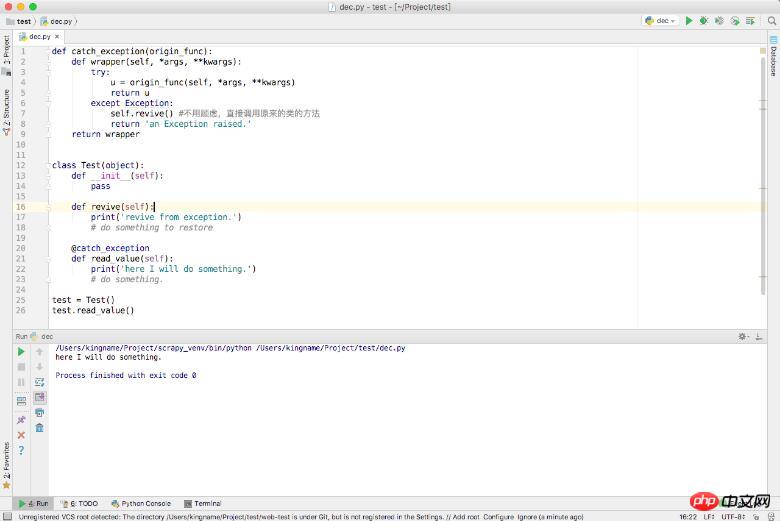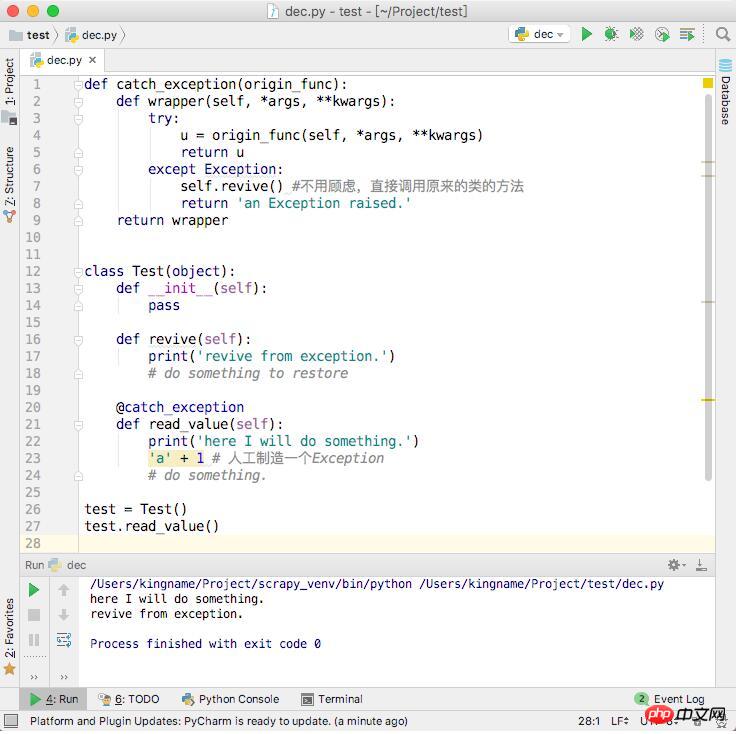Home >Backend Development >Python Tutorial >Decorate methods in classes based on Python decorators
Let me share with you an example of a method based on the Python decorator decoration class. It has a good reference value and I hope it will be helpful to everyone. Let’s take a look together
title: Methods in Python decorator decoration classes
comments: true
date: 2017-04-17 20:44: 31
tags: ['Python', 'Decorate']
category: ['Python']
---
At present, most of the information about Decorator tutorials all talk about how to decorate an ordinary function. This article introduces how to use Python's decorator to decorate a class method and call other methods in the class in the decorator function. This article takes catching an exception from a method as an example to illustrate.
There is a class Test, its structure is as follows:
class Test(object): def __init__(self): pass def revive(self): print('revive from exception.') # do something to restore def read_value(self): print('here I will do something.') # do something.
In the class There is a method read_value(), which is called in multiple places. For some reasons, the method read_value may randomly throw Exception and cause the program to crash. So you need to do try...except processing on the entire method. The ugliest approach is shown in the following code:
class Test(object):
def __init__(self):
pass
def revive(self):
print('revive from exception.')
# do something to restore
def read_value(self):
try:
print('here I will do something.')
# do something.
except Exception as e:
print(f'exception {e} raised, parse exception.')
# do other thing.
self.revive()
Writing like this can solve the problem, but the code is not Pythonic.
Use decorators to solve this problem. Should the decorator function be written inside the class or outside the class? The answer is, write it outside the class. So since it is written outside the class, how to call other methods of this class?
First write one of the most common decorators for handling exceptions:
def catch_exception(origin_func): def wrapper(*args, **kwargs): try: u = origin_func(*args, **kwargs) return u except Exception: return 'an Exception raised.' return wrapper class Test(object): def __init__(self): pass def revive(self): print('revive from exception.') # do something to restore @catch_exception def read_value(self): print('here I will do something.') # do something.
This way of writing can indeed capture the exception of origin_func(), but what should we do if we need to call another method in the class to handle the exception when an exception occurs? The answer is to add a parameter to the wrapper: self.
The code becomes the following form:
def catch_exception(origin_func): def wrapper(self, *args, **kwargs): try: u = origin_func(self, *args, **kwargs) return u except Exception: self.revive() #不用顾虑,直接调用原来的类的方法 return 'an Exception raised.' return wrapper class Test(object): def __init__(self): pass def revive(self): print('revive from exception.') # do something to restore @catch_exception def read_value(self): print('here I will do something.') # do something.
Only the part defined by the decorator needs to be modified, and no modification is required where the decorator is used.
The following picture shows the running results during normal operation:

The following picture shows the capture after an exception occurs And handle exceptions:

# By adding a self parameter, the decorator outside the class can directly use various methods in the class, or directly use the attributes of the class.
Related recommendations:
python decorator - method to limit the number of function calls (call once every 10 seconds)
The above is the detailed content of Decorate methods in classes based on Python decorators. For more information, please follow other related articles on the PHP Chinese website!